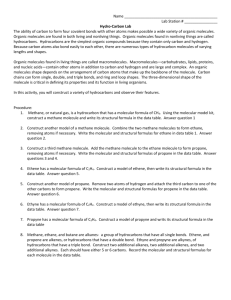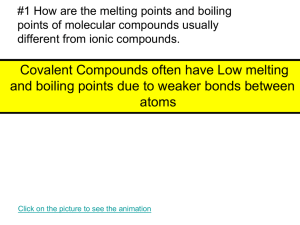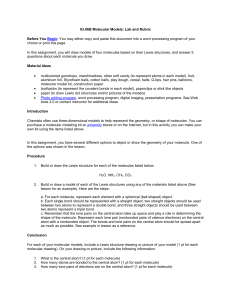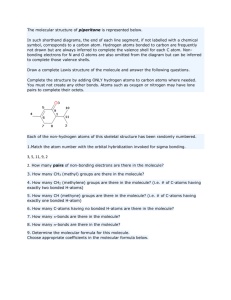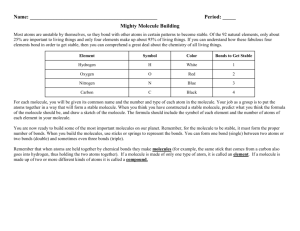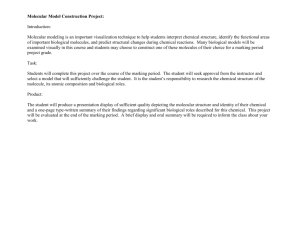Name Lab Station # Hydro-Carbon Lab The ability of carbon to form
advertisement
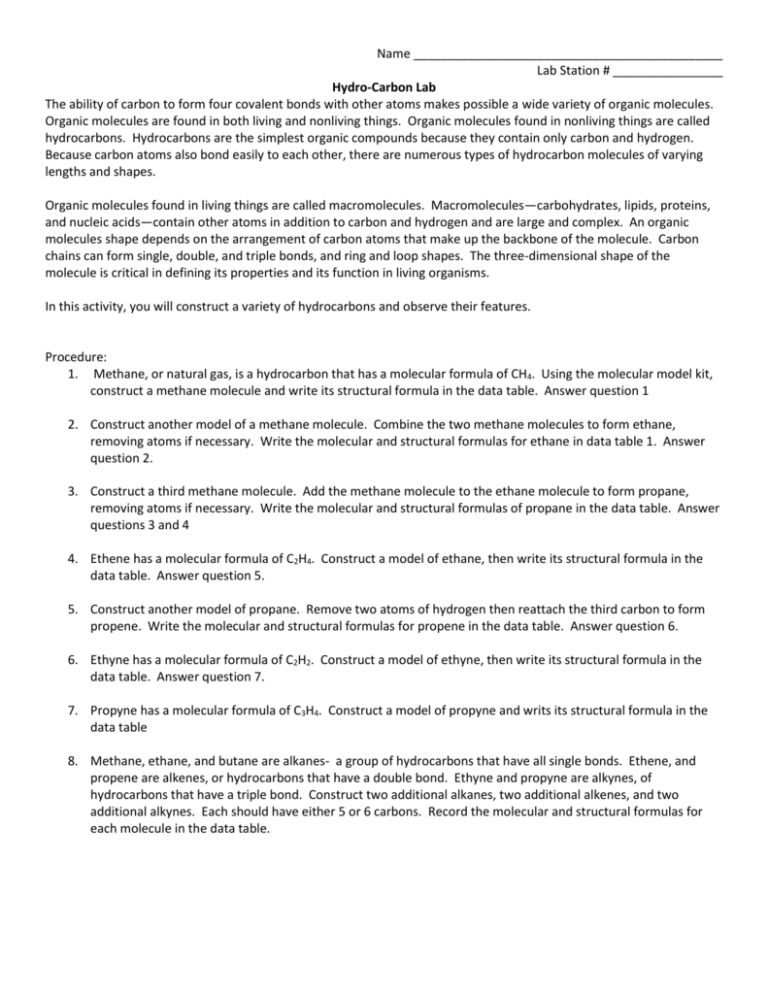
Name _____________________________________________ Lab Station # ________________ Hydro-Carbon Lab The ability of carbon to form four covalent bonds with other atoms makes possible a wide variety of organic molecules. Organic molecules are found in both living and nonliving things. Organic molecules found in nonliving things are called hydrocarbons. Hydrocarbons are the simplest organic compounds because they contain only carbon and hydrogen. Because carbon atoms also bond easily to each other, there are numerous types of hydrocarbon molecules of varying lengths and shapes. Organic molecules found in living things are called macromolecules. Macromolecules—carbohydrates, lipids, proteins, and nucleic acids—contain other atoms in addition to carbon and hydrogen and are large and complex. An organic molecules shape depends on the arrangement of carbon atoms that make up the backbone of the molecule. Carbon chains can form single, double, and triple bonds, and ring and loop shapes. The three-dimensional shape of the molecule is critical in defining its properties and its function in living organisms. In this activity, you will construct a variety of hydrocarbons and observe their features. Procedure: 1. Methane, or natural gas, is a hydrocarbon that has a molecular formula of CH4. Using the molecular model kit, construct a methane molecule and write its structural formula in the data table. Answer question 1 2. Construct another model of a methane molecule. Combine the two methane molecules to form ethane, removing atoms if necessary. Write the molecular and structural formulas for ethane in data table 1. Answer question 2. 3. Construct a third methane molecule. Add the methane molecule to the ethane molecule to form propane, removing atoms if necessary. Write the molecular and structural formulas of propane in the data table. Answer questions 3 and 4 4. Ethene has a molecular formula of C2H4. Construct a model of ethane, then write its structural formula in the data table. Answer question 5. 5. Construct another model of propane. Remove two atoms of hydrogen then reattach the third carbon to form propene. Write the molecular and structural formulas for propene in the data table. Answer question 6. 6. Ethyne has a molecular formula of C2H2. Construct a model of ethyne, then write its structural formula in the data table. Answer question 7. 7. Propyne has a molecular formula of C3H4. Construct a model of propyne and writs its structural formula in the data table 8. Methane, ethane, and butane are alkanes- a group of hydrocarbons that have all single bonds. Ethene, and propene are alkenes, or hydrocarbons that have a double bond. Ethyne and propyne are alkynes, of hydrocarbons that have a triple bond. Construct two additional alkanes, two additional alkenes, and two additional alkynes. Each should have either 5 or 6 carbons. Record the molecular and structural formulas for each molecule in the data table. 1. Create each molecule. Fill in the molecular and structural formulas. Hydrocarbon molecule Molecular formula Structural formula Methane CH4 Ethane Propane 2. What do you notice about the number of bonds carbon can make?_________________________ 3. What do you notice about the number of bonds between each carbon for the –ane molecule?________ 4. Create each molecule. Fill in the molecular and structural formulas. Hydrocarbon molecule Molecular formula Ethene Structural formula C2H4 Propene 5. What do you notice about how many bonds carbon makes?_____________________________ 6. What do you notice about the number of bonds between each carbon for the –ene molecule?________ 7. Create each molecule. Fill in the molecular and structural formulas. Hydrocarbon molecule Molecular formula Ethyne C2H2 Propyne C3H4 Structural formula 8. What do you notice about how many bonds carbon makes?______________ 9. What do you notice about the number of bonds between each carbon for the –yne molecule?________ Discussion Questions: 10. How many bonds are between –ane hydrocarbons?____________ 11. How many bonds are between –ene hydrocarbons?____________ 12. How many bonds are between –yne hydrocarbons?____________ 13. Describe a trend relating the names of the hydrocarbons (-ane, -ene, -yne) and the number of bonds between the carbon atoms? 14. How many bonds did carbon always make? __________ 15. How many bonds did hydrogen always make?___________ 16. What atoms had to be removed in order to join together the two methane molecules? 17. In the ethane molecule, how many electrons are being shared?___________________ 18. In the ethane molecule, what type of bond is formed between the carbon atoms?_________________ 19. What is the process called when you put together two molecules of methane to form ethane and water? (HINT: methane + methane ethane + water)______________________________________ 20. What do you think you would have to add to break ethane into methane?______________________ (HINT: ethane + ________ methane + methane) 21. What is the name of the reaction in number 20 called?__________________________________ 22. Draw at least three ways in which five carbon atoms could be joined to make different carbon skeletons. a. b. c. d. e.

